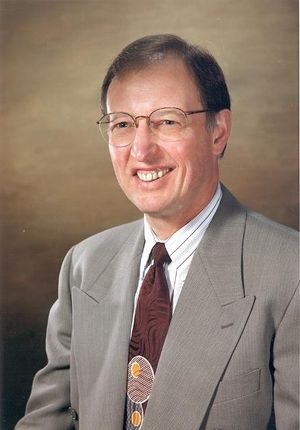Ronald A. Rohrer: Difference between revisions
(Created page with "==Biography== Considered one of the preeminent researchers on design optimization during the 1960s, Ronald A. Rohrer’s contributions to improving integrated circuit (IC) produ...") |
No edit summary |
||
| Line 1: | Line 1: | ||
==Biography== | ==Biography== | ||
[[Image:Ron Rohrer 2289.jpg|thumb|right]] | |||
Considered one of the preeminent researchers on design optimization during the 1960s, Ronald A. Rohrer’s contributions to improving integrated circuit (IC) production have spanned over 40 years. Dr. Rohrer realized early on that circuit simulation was crucial to IC design for progress in size reduction and complexity. Among his achievements was introducing a sequence of circuit simulation courses at the University of California, Berkeley that resulted in the CANCER (Computer Analysis of Nonlinear Circuits, Excluding Radiation) simulation program, enabling unprecedented efficiency and circuit size capability. CANCER evolved into the [[Milestones:SPICE Circuit Simulation Program|SPICE (Simulation Program with Integrated Circuit Emphasis)]] tool, now considered the industry standard for IC design simulation. During the 1980s, at Carnegie Mellon University, Dr. Rohrer introduced the Asymptotic Waveform Evaluation (AWE) algorithm, which enables highly efficient timing simulation of ICs containing large numbers of parasitic elements. | |||
[[Category:Circuitry | An [[IEEE Fellow Grade History|IEEE Life Fellow]], Dr. Rohrer is University Professor Emeritus of Electrical and Computer Engineering at Carnegie Mellon University in Pittsburgh, Pennsylvania. | ||
{{DEFAULTSORT:Rohrer}} | |||
[[Category:Circuitry]] | |||
[[Category:Computers_and_information_processing]] | |||
Revision as of 15:26, 21 August 2013
Biography
Considered one of the preeminent researchers on design optimization during the 1960s, Ronald A. Rohrer’s contributions to improving integrated circuit (IC) production have spanned over 40 years. Dr. Rohrer realized early on that circuit simulation was crucial to IC design for progress in size reduction and complexity. Among his achievements was introducing a sequence of circuit simulation courses at the University of California, Berkeley that resulted in the CANCER (Computer Analysis of Nonlinear Circuits, Excluding Radiation) simulation program, enabling unprecedented efficiency and circuit size capability. CANCER evolved into the SPICE (Simulation Program with Integrated Circuit Emphasis) tool, now considered the industry standard for IC design simulation. During the 1980s, at Carnegie Mellon University, Dr. Rohrer introduced the Asymptotic Waveform Evaluation (AWE) algorithm, which enables highly efficient timing simulation of ICs containing large numbers of parasitic elements.
An IEEE Life Fellow, Dr. Rohrer is University Professor Emeritus of Electrical and Computer Engineering at Carnegie Mellon University in Pittsburgh, Pennsylvania.
